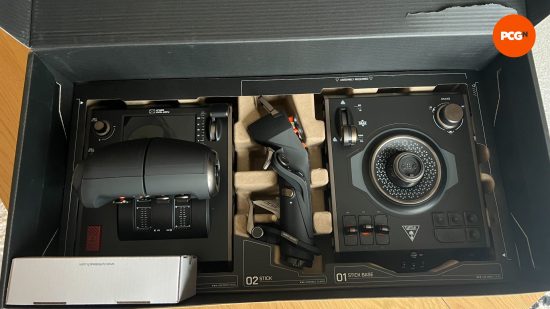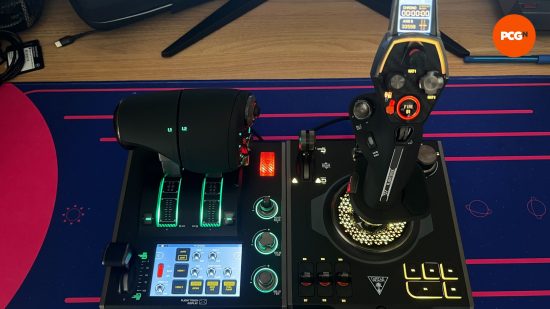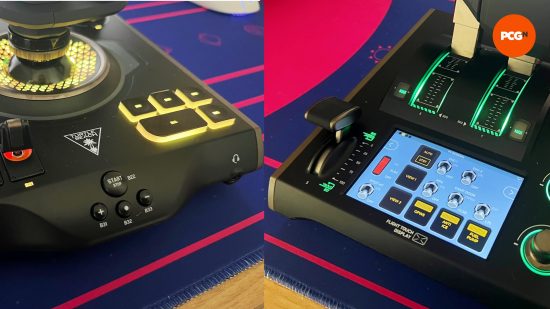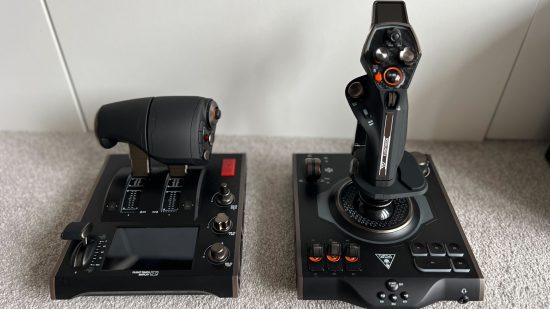Our Verdict
The Turtle Beach VelocityOne Flight Deck fully immerses you in any flight situation. Whether it’s Microsoft Flight Sim or War Thunder, Turtle Beach has nailed this HOTAS system on a performance level. However, the lack of built-in or game-specific binding profiles makes it hard to recommend for casual gamers right now.
- Incredible build quality
- Easy and quick to set up
- Immersion is hard to beat for a desktop setup
- Customizable lighting and OLED displays
- The layout can be overwhelming for new players
- Accompanying software sometimes crashes
Turtle Beach is no stranger to flight peripherals, but I would argue it’s not the first name that comes to mind when you imagine a flight stick. Following the release of the VelocityOne Flight Deck, however, that could be about to change. This HOTAS (hands-on throttle and stick) system offers a great, if pricey, flight control system with several layers of detail for experienced pilots.
In fact, after spending plenty of time using the Turtle Beach VelocityOne Flight Deck in a variety of flight sim and aerial combat games, I can confidently say that it is the best PC joystick for anyone looking for quality and depth. Yes, the sheer volume of inputs and displays can be overwhelming, but you’re also free to set up your experience to just cover surface-level needs if you wish.
Why you can trust our advice ✔ At PCGamesN, our experts spend hours testing hardware and reviewing games and VPNs. We share honest, unbiased opinions to help you buy the best. Find out how we test.
VelocityOne Flight Deck specs
| Buttons | 139 |
| Connection | USB-C |
| Throttle | Included |
| Weight | 2.97kg / 6.55lbs (total) |

VelocityOne Flight Deck features
The headline feature that stuck out to me on the VelocityOne Flight Deck is its dual displays. There’s a small OLED one on the joystick and a much larger touch-screen just below the throttle. These displays are customizable using the baked-in menu or via the dedicated software, which is downloadable from the Microsoft Store. Across these two displays, it’s possible to add up to 39 additional buttons, taking the total number of inputs to 139.
Within this massive selection of inputs, you’ll find dedicated landing gear and autopilot controls, with the latter being a feature that is still missing from many other competitors such as the Logitech G X55 and Thrustmaster Warthog. You also get six HAT/POV controls, with VelocityOne again leading the way versus competitors who can only muster a maximum of five.
The joystick and throttle also both take advantage of Hall Effect technology, which drastically reduces the risk of stick drift and negates the need for a dead zone, which is an area within a joystick’s movement area where no input is detected. These exist to offset stick drift which creates phantom movements in-game. It also creates a much more responsive experience as every slight input can be seen and felt as you make it.
Comprising two separate UBS units, the VelocityOne Flight Deck can be broken down and used as just a joystick if you’re in a rush or have no need for the throttle controls. However, if you wish to increase your immersion beyond just the Flight Deck, you can download the companion app on your smartphone or tablet to add more touch controls to your setup. I fired this up to expand my options within Microsoft Flight Sim, but often felt like I had little need for it as the various inputs on the Flight Deck itself were more than enough.

VelocityOne Flight Deck design
There’s no easy way to put this, but the design of the Turtle Beach VelocityOne Flight Deck is overwhelming. This isn’t inherently bad, but it’s well worth taking time to get acclimatized to the layout and key controls the first time you get it out of the box.
The initial setup process is super simple, with no need to fix the Flight Deck to a bracket or desk, as the weighted bases are more than sturdy enough to keep them still during gameplay. Each unit also has its own braided USB cable, meaning there’s minimum fuss involved with setting up this HOTAS system. You can also add a headset via the 3.5mm jack on the joystick unit.
The build quality of both the stick and throttle feels fantastic and there isn’t a single input or thumbstick that feels cheap or like if you apply too much pressure it will simply crumble and break. Real thought has gone into the design all the way down to the aforementioned braided USB cables making setting up and managing cables a breeze.
While the VelocityOne is definitely good-looking, it doesn’t reinvent the wheel when it comes to general layout. It still has to stay faithful to what gamers expect from a traditional HOTAS setup, while also striking the right balance between premium looks and practicality.
While some control functions are clearly marked, there are still plenty of blankly labeled inputs that you’re seldom going to remember from the generic number they’ve been assigned. Instead, it’s best to appreciate and get acclimatized to the layout of the Flight Deck first. You can then gain a deeper understanding of which buttons do what in a game that makes the most of every single input, such as Microsoft Flight Simulator.
When it comes time to pack the Flight Deck away, it’s a simple process if you want to use its original box, as you simply remove the joystick from the base by unscrewing it, and place all the parts back into their assigned areas. This is fantastic for pilots who don’t or can’t keep their HOTAS system out on display 24/7, and as previously mentioned, the setup process is incredibly simple for when you next want to play.

VelocityOne Flight Deck performance
Using the Turtle Beach VelocityOne Flight Deck is an incredibly smooth experience. It can be very easy to overlook and underappreciate just how well-designed it is, and the impact this has on the performance.
It’s little touches like the way the curvature of the joystick fits perfectly in the hand, and you can so naturally extend your pinky finger to clutch the brake input. It’s the satisfying resistance felt when sliding the throttle that gives it a feeling of importance and adds to the immersion that takes over when you’re in the game.
Another great example of the versatility of the VelocityOne Flight Deck is the ability to respond to anything you can throw at it. By this, I mean testing two drastically different games such as Microsoft Flight Sim and War Thunder. I never felt hampered or like I was laboring to get the Flight Deck to keep up with the sudden motion that an aerial dogfight demands, while the wealth of controls and inputs create an immediate immersion for Flight Sim that gets the best out of the game.
The implementation of Hall Effect outright makes the VelocityOne Flight Deck the cleanest and most responsive joystick I’ve had the pleasure of using. The moment motion is started, you can see a reaction in-game, all because there is no need for dead zones to account for potential stick drift.
There is also a different tactile response from each button type, which makes it super simple to identify where your hands are sitting on the controls without needing to check the position every few seconds.
Another neat touch is that, when adjusting the red slider next to the circular ‘fire’ input on the joystick, it transforms this basic button into a touch-sensitive trackpad that you can use to control the on-screen cursor. This is a brilliant addition that isn’t obviously signposted anywhere but is incredibly useful once you know about it.
It’s a shame that the Turtle Beach software you have to download is so prone to constant freezing and unresponsiveness whenever a firmware update is needed, which makes the task way more difficult than necessary. However, whenever firmware is updated, the software will then be fine to use until the next one is ready.
Bindings are available for a selection of games: Microsoft Flight Sim, War Thunder, Star Wars: Squadrons, Elite Dangerous, DCS World, Prepare3D, and X-Plane 11 & 12.
The level of bindings will vary game-to-game depending on whether the throttle controls are even needed and whether the game tracks the Flight Deck as a default input or specifically as the make and model. Either way, creating custom bindings is something many pilots will be used to, and while it can sometimes be a long process, it’s only a case of doing it once and saving the profile for future use.
VelocityOne Flight Deck conclusion
The Turtle Beach VelocityOne Flight Deck is a fantastic HOTAS system, only held back by its intimidating appearance to newcomers. Strong game support makes the VelocityOne irresistible given the build quality and in-game performance also on offer.
VelocityOne Flight Deck price
The Turtle Beach VelocityOne Flight Deck retails for $399.99 (£379.99), which is incredibly reasonable given the level of features and performance it offers over products such as the Thrustmaster Warthog, which is $150 more expensive.
VelocityOne Flight Deck alternatives
Thrustmaster T.Flight One HOTAS
If you’re not quite looking to spend $400, or simply want a controller that’s a little less imposing when it comes to getting to grips with it, the Thrustmaster T.Fight One HOTAS is ideal, as it costs a quarter of the price and it’s also compatible with Xbox.
